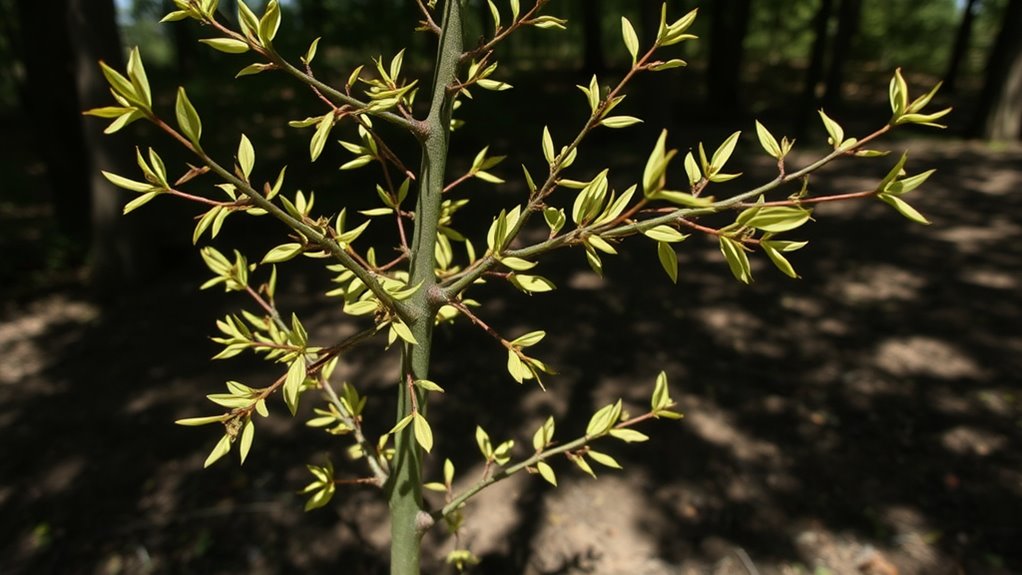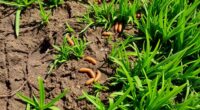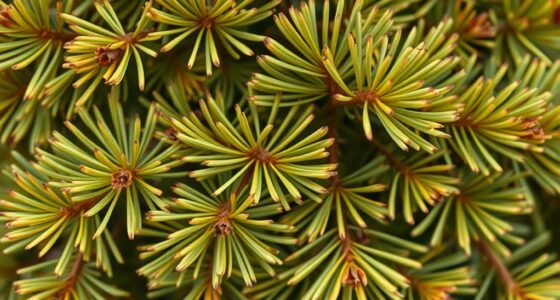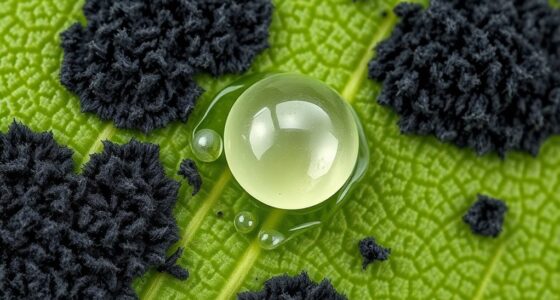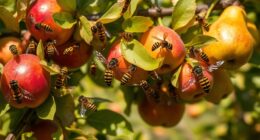To assess if your fine line buckthorn is dying, check its sunlight exposure—too little or too much can cause stress signs like dull foliage or sunscald. Examine the soil for poor drainage, compaction, or nutrient deficiencies, which impact health. Look for disease symptoms like discolored spots, mold, or wilting, and inspect for pests. Testing soil pH and nutrients helps identify underlying issues. Understanding these factors guides proper care to revive your plant or recognize when to seek help.
Key Takeaways
- Check for signs of sunburn like scorched leaf edges or peeling bark indicating excessive sun exposure.
- Assess soil drainage by performing a jar test and look for yellowing or stunted growth suggesting poor soil conditions.
- Inspect for pests or fungal symptoms such as spots, mold, or fuzzy growths that signal disease issues.
- Evaluate light levels to ensure the plant receives at least 4-6 hours of direct sunlight daily for optimal health.
- Conduct soil testing to identify nutrient deficiencies or pH imbalances that could cause decline.
Understanding the Sunlight Needs of Fine Line Buckthorn

Understanding the sunlight needs of Fine Line Buckthorn is essential for keeping this plant healthy. This shrub exhibits some sunlight adaptation but generally prefers full sun to partial shade. Its shade tolerance allows it to thrive in areas with limited direct sunlight, but too much shade can hinder growth and cause the plant to weaken. Ideally, you should place it where it receives at least 4-6 hours of direct sunlight daily. If grown in shadier spots, expect slower development and less vibrant foliage. Ensuring proper light exposure helps maintain its health and appearance. Proper sunlight exposure is crucial, as too little or too much can stress the plant, making it more susceptible to issues like disease or pest problems. Additionally, incorporating proper soil conditions can significantly support its growth and resilience.
Identifying Signs of Sunburn and Insufficient Light

You can spot sunburn and poor lighting by looking at leaf discoloration patterns, which often turn yellow or brown on the edges. Changes in the stem and bark, like cracking or peeling, also signal stress from too much or too little light. Paying attention to these signs helps you determine if your buckthorn needs adjustments to its sunlight exposure. Additionally, understanding types of light exposure can guide you in providing the optimal environment for healthy growth. For example, different light conditions can reflect the personality or appearance of your plant, helping you select a fitting name for your buckthorn.
Leaf Discoloration Patterns
When leaves on your fine line buckthorn start to change color, it often signals underlying issues with light exposure. Recognizing leaf discoloration patterns helps you identify whether your plant is suffering from sunburn or inadequate light. Sunburn typically causes irregular, scorched-looking patches, often on the upper or exposed leaves, with browning or bleaching. In contrast, insufficient light leads to uniform fading, with leaves turning pale or yellowish and losing their vibrant hue. Pattern recognition is key—you’ll notice whether discoloration is patchy or consistent across the plant. By observing these signs closely, you can determine if your buckthorn needs more sun or protection from excessive exposure, ensuring you take appropriate steps to promote healthy foliage.
Stem and Bark Changes
Changes in the stem and bark of your fine line buckthorn can reveal whether it’s suffering from sunburn or insufficient light. If the bark texture becomes rough, cracked, or peeling, it may indicate sunburn damage, especially on exposed areas. Sunburned stems often show signs of scorching, with noticeable discoloration or sunscald patches. Conversely, if your plant isn’t getting enough light, the stem thickness may decrease, resulting in thinner, weaker stems that lack vigor. In low-light conditions, the bark may appear dull or less textured, and the plant may exhibit elongated, leggy growth as it stretches toward the light source. Monitoring these stem and bark changes helps you determine whether to adjust your plant’s location to prevent further stress. Additionally, understanding plant stress signals can guide you in providing optimal conditions for healthy growth. Regular observation of these signs can also help detect underlying issues like thermal stress or pest damage that can affect overall plant health. Being aware of drainage and watering practices is also crucial, as improper watering can exacerbate stress symptoms and hinder recovery.
Evaluating Soil Composition and Drainage

Understanding the soil composition and drainage is essential for diagnosing the health issues of fine line buckthorn. Poor soil drainage can lead to root rot, while soil texture influences water retention and aeration. To evaluate your soil, test its drainage by observing how quickly water moves after watering. A simple jar test helps determine soil texture—sand, silt, or clay dominance. Additionally, maintaining vibrational energy through positive care can support plant vitality and resilience. Recognizing the importance of soil health can further enhance your understanding of plant needs and promote healthier growth.
Recognizing Symptoms of Soil-Related Stress

Soil-related stress in fine line buckthorn often shows through visible signs that indicate underlying issues. One common symptom is poor growth or yellowing leaves, which can result from soil compaction restricting root expansion and oxygen flow. You might also notice the plant’s roots struggling to spread, leading to wilting despite adequate watering. Inconsistent watering frequency can exacerbate soil stress—either overwatering, causing root rot, or underwatering, leading to dehydration. Check for compacted soil by gently loosening the top layer; if it feels hard or dense, it’s likely impeding root health. Recognizing these symptoms early helps you adjust watering practices and improve soil conditions, reducing stress and supporting the buckthorn’s recovery. Monitoring soil health and structure can provide further insights into underlying issues affecting your plant, including potential disease presence that may compromise root vitality. Additionally, assessing the soil pH can help identify nutrient imbalances that may contribute to plant stress.
Detecting Common Diseases Affecting Buckthorn

When you notice signs of poor growth or wilting in your buckthorn, it’s important to consider that diseases might be the cause. Early detection is key to saving your plant. Look for:
Watch for signs of disease like wilting or discolored leaves to save your buckthorn early.
- Discolored or speckled leaves indicating fungal issues
- Wilting despite adequate watering
- Dark spots or lesions on stems
- Powdery or fuzzy growth, hinting at mold
- Unusual leaf drop or dieback, which can also be related to plant health management.
Effective pest management helps prevent disease spread, while proper pruning techniques improve air circulation and reduce infection risk. Keep an eye out for symptoms that suggest disease presence, and act promptly. Removing affected branches limits the infection’s reach. Remember, timely intervention can save your buckthorn from decline and ensure healthy growth. Additionally, understanding beneficial nutrients and antioxidants can support overall plant resilience and health.
Inspecting for Pests and Fungal Infections

Regularly inspecting your buckthorn for pests and fungal infections is essential for maintaining its health. Start by looking for signs of pest infestation, such as tiny holes in leaves, sticky residue, or visible insects. Accurate pest identification helps determine the appropriate treatment. Check for fungal symptoms like discolored or wilting leaves, fuzzy growths, or black spots on stems and foliage. Early detection allows you to address issues before they spread. Use a magnifying glass if necessary to spot small pests or fungal spores. Keep an eye on new or unusual growth patterns, which can indicate underlying problems. Regular inspections enable you to catch problems early and take swift action, preserving your buckthorn’s vigor and preventing more severe damage. Incorporating proper plant care practices can also bolster the tree’s natural defenses against pests and diseases, including monitoring for signs of disease or stress, and ensuring optimal air circulation and soil health to reduce disease susceptibility.
Testing Soil Ph and Nutrient Levels

To ascertain if soil issues are affecting your buckthorn, you need to test its pH and nutrient levels. Using the right tools and following proper procedures guarantees accurate results. Understanding the ideal soil pH range and common deficiency signs can help you take targeted action. Incorporating soil testing techniques can pinpoint specific nutrient imbalances or deficiencies.
Testing Procedures and Tools
Accurately testing soil pH and nutrient levels is essential for diagnosing the health of Buckthorn plants. Using simple testing procedures and tools allows you to identify deficiencies or imbalances that hinder growth. You can use digital soil testers, test kits, or send samples to a lab for precise analysis. Proper testing helps you adjust watering schedules and refine pruning techniques, ensuring ideal conditions. Be mindful of these emotional triggers:
- Feel confident in your ability to nurture healthy plants
- Detect problems before they cause irreversible damage
- Understand your soil’s true needs, not guesswork
- Prevent unnecessary stress on your Buckthorn
- Achieve a thriving, vibrant landscape you’re proud of
Regular testing empowers you to make informed decisions, giving your Buckthorn the best chance to flourish.
Ideal Soil Ph Range
What is the ideal soil pH range for Buckthorn, and why does it matter? Buckthorn thrives in slightly acidic to neutral soil, typically between 6.0 and 7.0 pH. Maintaining this range helps the plant absorb nutrients efficiently, promoting healthy growth. If your soil is too acidic or alkaline, consider soil amendments like lime or sulfur to adjust the pH accordingly. Regular testing guarantees you stay within the suitable range. Additionally, adjusting your watering schedule can influence pH over time, as frequent watering can leach nutrients and alter soil chemistry. Proper pH levels support root development and overall plant health, reducing stress factors that can lead to dieback. Monitoring and maintaining the correct pH is essential for preventing Buckthorn decline.
Nutrient Deficiency Indicators
Regularly testing your soil’s pH and nutrient levels is essential for diagnosing potential deficiencies that can cause Buckthorn to decline. When nutrient imbalances occur, you might notice changes in foliage color, such as yellowing or dullness, signaling deficiencies like nitrogen or iron. Poor root health often accompanies these issues, making the plant less able to absorb nutrients. Keep an eye out for:
- Pale or discolored foliage
- Stunted growth or dieback
- Wilting despite adequate watering
- Unusual leaf spotting or curling
- Weak or rotted roots
Addressing these signs early by testing and adjusting soil nutrients can restore plant vigor. Proper nutrient levels promote vibrant foliage and healthy roots, helping your Buckthorn thrive instead of decline.
Adjusting Care Practices for Optimal Plant Health

To promote healthy growth and prevent further decline of your fine line buckthorn, adjusting your care practices based on its current condition is vital. Start with proper pruning techniques to remove dead or diseased branches, encouraging airflow and reducing disease risk. Be careful not to over-prune, as this can stress the plant further. Review your watering schedules; buckthorns prefer deep, infrequent watering rather than frequent shallow sessions. Guarantee the soil drains well to avoid waterlogging, which can lead to root rot. Mulch around the base to retain moisture and regulate soil temperature. Regularly monitor the plant’s response to these adjustments, and make incremental changes to optimize its health. Consistent, tailored care helps your buckthorn recover and thrive.
When to Seek Professional Assistance
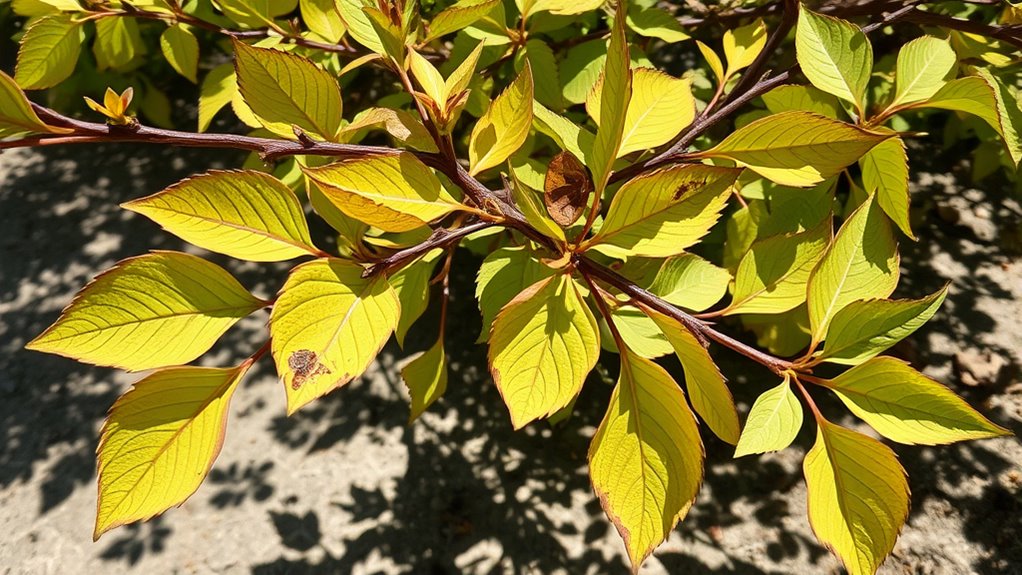
If your efforts to adjust care practices aren’t stopping the decline of your fine line buckthorn, it’s time to contemplate professional help. A certified arborist or plant specialist can evaluate your pruning techniques and watering routines to identify underlying issues. They can also diagnose diseases or pests that might be invisible to the untrained eye. Consider seeking help if you notice:
- Persistent leaf discoloration despite watering adjustments
- Sudden dieback or extensive branch loss
- Unresponsive pruning efforts that don’t improve health
- Signs of disease or pest infestation
- Growing anxiety over losing your plant’s beauty and value
Professional assistance can save your buckthorn before it’s too late, offering tailored solutions that restore its robustness and prevent future decline.
Frequently Asked Questions
How Can I Prevent Buckthorn From Dying Unexpectedly?
To prevent your buckthorn from dying unexpectedly, you should focus on proper pruning techniques to promote healthy growth and remove any diseased or dead branches. Maintain a consistent watering schedule, ensuring the plant gets enough moisture without overwatering. Also, check the sun exposure and soil conditions regularly to keep the plant healthy. Proper care, including timely pruning and adequate watering, helps your buckthorn thrive and resist stress factors.
What Are Natural Remedies for Buckthorn Disease Management?
You can manage buckthorn diseases naturally by using organic treatments like neem oil or compost teas to boost plant health. Companion planting with herbs such as garlic or marigolds can also deter pests and reduce disease spread. Regularly inspect your buckthorn, remove infected parts promptly, and avoid chemical pesticides. These eco-friendly strategies help keep your buckthorn healthy and resilient without harming the environment.
Can Weather Changes Affect Buckthorn Health Significantly?
Weather changes, especially seasonal variations, can considerably impact buckthorn health. Climate impact causes stress on the plant, making it more vulnerable to diseases and pests. Sudden temperature shifts, droughts, or excessive rain can weaken its roots and foliage. You should monitor these changes closely, as they can lead to decline or death if the buckthorn isn’t adapted or properly cared for during fluctuating weather conditions.
Are There Specific Fertilizers Beneficial for Buckthorn Recovery?
You should consider using a slow release fertilizer or organic compost to help your buckthorn recover. These fertilizers provide nutrients gradually, promoting healthy growth and resilience. Organic compost enriches the soil naturally, improving nutrient availability. Avoid over-fertilizing, as this can harm the plant. Regular feeding with a balanced, slow-release fertilizer encourages strong root development and overall health, especially if your buckthorn has been stressed by environmental factors or disease.
How Do I Differentiate Between Pest Damage and Disease Symptoms?
Think of diagnosing your buckthorn like Sherlock Holmes with a magnifying glass. You’ll notice leaf discoloration and bark lesions, but these signs differ. Pest damage often causes irregular holes or chewed edges, while disease symptoms show as spots, cankers, or oozing. By carefully examining these clues, you can distinguish pests from diseases, ensuring you treat the right issue and help your buckthorn recover.
Conclusion
If you ignore these signs, your fine line buckthorn could wither away faster than you can say “green thumb disaster.” By paying close attention to sunlight, soil, and disease, you’ll turn things around before your plant’s last leaf falls. Act now, adjust your care, and watch your buckthorn thrive like never before—because a healthy plant isn’t just a goal, it’s a glorious victory in your garden!
